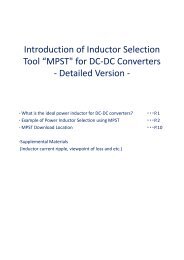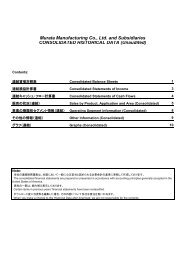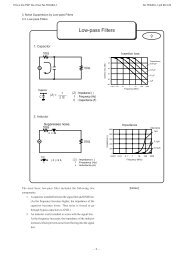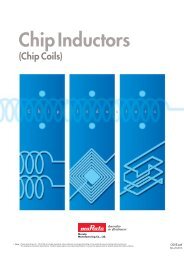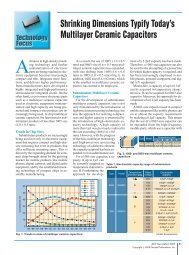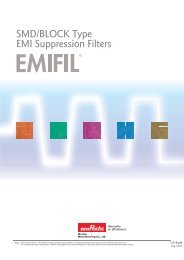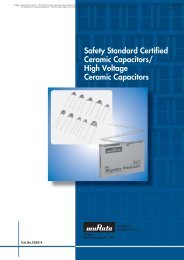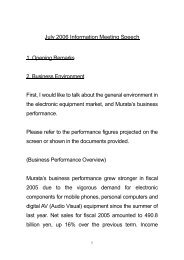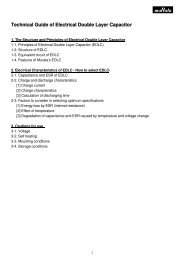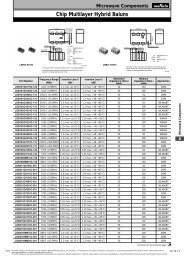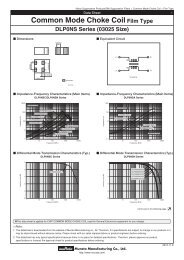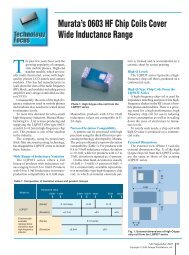Murata Taps Capacitive-Coupled Method for Wireless Power Transfer
Murata Taps Capacitive-Coupled Method for Wireless Power Transfer
Murata Taps Capacitive-Coupled Method for Wireless Power Transfer
- No tags were found...
You also want an ePaper? Increase the reach of your titles
YUMPU automatically turns print PDFs into web optimized ePapers that Google loves.
cannot be provided by other methods.Among the advantages of the fieldcoupledmethod, are 1) high degree offlexibility in positioning the couplingdevices; 2) high degree of flexibility indesigning the electrode shape and dimensions,and 3) electrode with less heatgeneration.Fig. 3 shows the power transmissionefficiency graph in relation to displacementbetween the coupling devices (betweenelectrodes in the case of the fieldcoupledmethod and between coils inthe case of an electromagnetic inductionmethod). When displacement (dz/D) betweenelectrodes is one, the electrodes(in the case of the field-coupled method)or coils (in the case of an electromagneticinduction method) of power-sendingand power-receiving sides hardlyoverlap with each other and they areconsiderably displaced (electrodes aredisplaced by a length of one diameter).Even in this condition, the drop in powertransmission efficiency of the field-coupledmethod is about 20 percent. Whendisplacement of the electrodes is small,the drop in the power transmission efficiencyof the field-coupled method staysat about 10 percent. In this way, the fieldcoupledmethod offers a high degree offlexibility in positioning coupling devicesin a horizontal direction, and makesit possible to construct an electric powercharging system that is easy to use bythe consumers, <strong>for</strong> example, charging amobile phone even if it is placed slightlydislodged on the charger.As a way of improving the degree offlexibility in positioning coupling devices,multiple electrodes can be switchedto transmit electric power. This methodcan charge the power-receiving equipmenthighly efficiently regardless of itslocation on a charger because it operatesonly the electrode at the placement locationof the power-receiving equipment.Furthermore, this method is noise freeand enables developing a system thathas an extremely low effect on the user’sbody or on the device to be charged.The second advantage of this methodis that it provides a high degree of flexibilityin designing the electrode shapeand dimensions. As long as the desiredcapacity of electric power to be transmittedis obtained between the power-transmissionand power-receiving electrodes,there is no restriction regarding theshapes and dimensions of the electrodes.The electrode does not have to be rectangularand any shape can be adopted,such as a triangle or circle. Moreover,in the case of the field-coupled method,the electric current that flows to the electrodesis extremely small (several milliamperes).Consequently, there is almostno restriction on the materials to be usedto construct the electrode and its thickness.The thickness of electrodes thatcan be used is less than several micrometers(see Fig. 4). There<strong>for</strong>e, <strong>Murata</strong> canrespond to wide-ranging customer needswith regard to electrode shape, dimensions,and materials.The third advantage of this method isHigh degree of positioning flexibility in the horizontal directionthat there is almost no heat generation inthe electrode. As mentioned above, theelectric current that flows to the electrodeof the field-coupled method is lessthan several milliamperes and there isalmost no Joule heat, which is producedby the electric current and resistance. Asa result, this method can be used to realizea safe system that does not causedamage to a battery even if the electrodeis placed near it.Equipment Applications, Trends<strong>Murata</strong> has used this power transmissionsystem <strong>for</strong> tablet terminals, e-bookterminals, and smartphones, and hasComparison of power transmission efficiency between the field – coupledmethod and electromagnetic induction method in relation to couplingdevice displacement (DC input - DC output)<strong>Power</strong>-receiving side10%electrode or coil =30mmField couplingdz80% 0%40%EFF-10%-20%-30%-40%-50%-60%Electromagneticinduction-70%0 0.2 0.4 0.6 0.8 1 1.2relative displacement(dz/D);, D:diameter of ElectrodeFig. 3: Free positioningFig. 4: Electrode with highly flexible shapes and low-profile structureL-coupledC-coupledD<strong>Power</strong>-sending sideelectrode or coil=40mm36 AEI November 2011
Fig. 5: Example of 10W systemFig. 6: Prototype <strong>for</strong> e-book (4W × 2)been developing prototype chargers andjackets. The maximum power transmissionof 10W has been achieved <strong>for</strong> tabletterminal application. Fig. 5 showsthe specifications of the 10W powertransmissionand power-receiving modulesand an example of the prototype10W power transmission system. Thissystem has a high power transmissionefficiency of 70 percent and its chargingtime is equal to that of a charger connectedusing a cable. Today, mobile devicesuse higher-capacity batteries andtablet terminals use a battery of 5Ah orhigher. There<strong>for</strong>e, these devices requirea power transmission capacity of about10W <strong>for</strong> charging and this module canmeet the demand. The charger (shownin Fig. 5) uses a transparent material(indium tin oxide or ITO) <strong>for</strong> electrodesin order to provide a high designingflexibility that cannot be achieved byother methods.The e-book terminal wireless chargingsystem (shown in Fig. 6) uses amechanism <strong>for</strong> switching the multipleelectrodes (as mentioned in the previoussection) in order to expand the chargingarea. This charging system can chargetwo e-book terminals placed in any locationon this system. An entire desk atthe users’ office or an entire table at theirhome can be turned into a charger byfurther evolving this mechanism. <strong>Murata</strong>can develop a highly convenient chargingsystem <strong>for</strong> consumers that wouldmake it possible to charge a terminal byplacing it anywhere on an office desk ora table.Future Ef<strong>for</strong>ts<strong>Murata</strong> intends to make a concertedef<strong>for</strong>t to resolve the issues on 1) sizereduction of the module; 2) expansionof the power transmission range (5W to50W), and 3) standardization.Size reduction of the modules (powerreceivingmodule, in particular) is absolutelynecessary in order to install themin compact devices such as smartphonesand digital cameras. There<strong>for</strong>e, <strong>Murata</strong>is working towards miniaturizing a keycomponent of the modules, namely, thevoltage conversion trans<strong>for</strong>mer. As oneof the methods <strong>for</strong> miniaturizing thetrans<strong>for</strong>mer, <strong>Murata</strong> is providing moreinsight <strong>for</strong> the development of devicesthat can operate at a higher power transmissionfrequency.Regarding the issue of expandingthe power transmission range, <strong>Murata</strong>is carrying out the development <strong>for</strong> expansionto 50W by focusing on chargingnotebook computers. Radio law-relatedissues apply after 50W power transmissionis achieved. <strong>Murata</strong> has set up aplan that looks ahead to the developmentof power transmission technologies <strong>for</strong>achieving up to the 100W level.Furthermore, to expand the wirelesssystem, mutual connectivity must be assuredby standardization. <strong>Murata</strong> has alreadystarted activities <strong>for</strong> standardizingthe field-coupled method and has beenpushing <strong>for</strong>ward with the planning oftechnology standards and the creation ofa business plat<strong>for</strong>m. The important pointin the technological aspect is to developa charging system that can charge manydifferent types of devices. In addition tostandardization of the system, <strong>Murata</strong>is aiming to develop a system that cancharge devices that operate on differentelectric power voltages and come in differentsizes by taking advantage of thefield-coupled method.About this Article:The author, Shinji Goma, is part ofthe Technology & Business IntegratedProducts Department, Planning Sectionat <strong>Murata</strong> Manufacturing Co., Ltd.AEI November 201137




